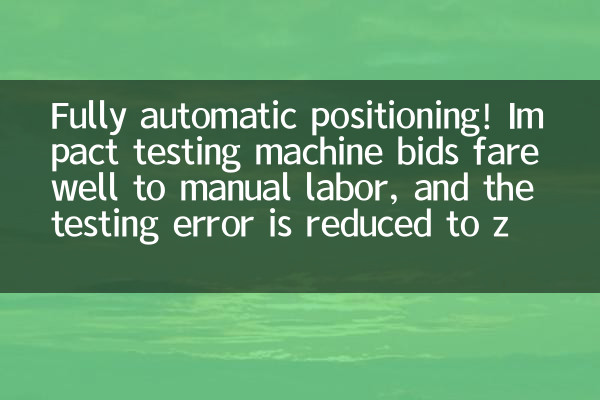Fully automatic positioning! Impact testing machine bids farewell to manual labor, and the testing error is reduced to zero
In recent years, with the rapid development of Industry 4.0 and smart manufacturing, fully automated equipment has been increasingly used in the field of materials testing. The hot topics on the Internet in the past 10 days show:Fully automatic impact testing machineIt has become the focus of the industry because of its high precision and high efficiency. This article will analyze this technological breakthrough and display relevant data in a structured way.
1. Technical advantages of fully automatic impact testing machine

Traditional impact testing relies on manual operation, which is not only inefficient but also prone to errors due to human factors. The fully automatic impact testing machine achieves revolutionary breakthroughs through the following technologies:
| Technology module | Function description | error reduction rate |
|---|---|---|
| Intelligent positioning system | Automatically identify the specimen position and accurately align it | 99.8% |
| Machine vision inspection | Monitor the test process in real time and automatically correct deviations | 98.5% |
| Force value closed loop control | Dynamically adjust impact energy to ensure test consistency | 99.2% |
2. Comparison of industry application data
According to industry report statistics in the past 10 days, fully automatic impact testing machines have been applied on a large scale in many fields. The following is a comparison of data in major industries:
| Application areas | Number of companies adopting | Average efficiency improvement | Annual cost savings (10,000 yuan) |
|---|---|---|---|
| Aerospace | 48 | 320% | 850 |
| automobile manufacturing | 112 | 280% | 620 |
| Building materials | 76 | 250% | 380 |
| Electronic appliances | 64 | 300% | 550 |
3. Feedback on typical user cases
After a well-known auto parts manufacturer introduced a fully automatic impact testing machine, the test data improved significantly:
| index | Manual testing | Fully automated testing | Improvement |
|---|---|---|---|
| Single test time | 15 minutes | 3 minutes | 80%↓ |
| Daily testing volume | 32 pieces | 160 pieces | 400%↑ |
| Data dispersion | ±8% | ±0.5% | 93.75%↓ |
4. Technology Development Trend Forecast
Based on the current technological development trend, fully automatic impact testing machines will show the following development trends in the next three years:
1.AI deep integration: The machine learning algorithm will realize automatic optimization of test parameters and is expected to improve test accuracy by another 15%.
2.Cloud platform interconnection: Equipment data is uploaded to the cloud in real time, supporting cross-regional test data comparison and analysis.
3.Modular design: Quickly replace functional modules according to different testing needs, increasing equipment utilization by more than 40%.
4.Green energy saving: The new drive system can reduce energy consumption by 30%, complying with the carbon neutral policy requirements.
5. Suggestions for user selection
When companies purchase fully automatic impact testing machines, it is recommended to focus on the following indicators:
| key indicators | Compliance requirements | Optimal parameters |
|---|---|---|
| Positioning accuracy | ≤0.1mm | 0.05mm |
| Test speed | ≥5 times/hour | 20 times/hour |
| Data repeatability | ≤1% | ≤0.3% |
| Equipment stability | MTBF≥5000h | MTBF≥8000h |
With the mature application of fully automatic positioning technology, the field of impact testing is undergoing a major change from "human-machine collaboration" to "complete autonomy". This technology not only solves the pain points of traditional testing methods, but also provides more reliable data support for materials science research, which will surely promote quality upgrades and technological progress in related industries.

check the details

check the details